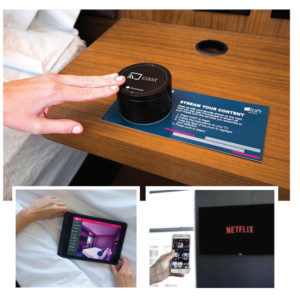NEW ORLEANS—The Aloft brand has always been technology-driven, aiming to give its future-focused and digitally savvy guests the latest innovations—whether that’s robots, emojis or an easy solution to BYOD. In the heart of the Big Easy, at Aloft New Orleans Downtown, the brand is piloting TeleAdapt’s Roomcast powered by Google Chromecast solution for guests, which allows them to stream content, safely, from their very own smart devices—smartphones, tablets and laptops—directly to the TV in their guestroom.

In a few simple steps, hotel guests can cast content from their own devices onto the guestroom television.
In recent years, hotels have struggled with the guest tendency to bring their own device—and, in the case of most guests, several devices—eschewing the once-revenue-generating guestroom TV in favor of their own tiny screens. Wanting to elevate the experience, hotels have sought ways to adapt to this growing trend. This was most evident at last year’s HITEC, held here in New Orleans, where enterprise-ready casting and streaming solutions were one of the most-talked-about technology solutions on display. (Indeed, the Aloft New Orleans Downtown hosted a demo and launch event for TeleAdapt’s Roomcast, which coincided with the annual technology show.)
With multiple solutions now on the market for hospitality, why was this particular technology chosen? “Well, in the true spirit of innovation at Aloft, we had to jump onto the opportunity to debut yet another game-changing industry first,” maintained Eric Marlo, director of design & development, distinctive brands at Marriott International Inc. He continued, “We have seen a huge shift in content within our guestrooms. There has been a steady incline in the number of devices the modern-day guest travels with, and the majority of these guests are bringing their own content. Because of this, we needed to shift the way we look at in-room guest entertainment. The Chromecast initiative is an industry first, state-of-the-art development that allows users to cast their own content from a variety of devices onto the screens in front of them.”
Chromecast is also device agnostic—meaning it is app driven and can be used whether you have an iPhone or any other type of smartphone. With RoomCast, the hotel—and the guest—have incredible flexibility.
Truly, this is a must-have in the guestrooms of millennials and baby boomers alike, many of whom are used to having this type of technology in their televisions at home. It was clear to Marlo that Google’s Chromecast was emerging as a top solution. In turn, Teleadapt, a hospitality connectivity company, was able to take this solution to a commercial environment.
 One of the biggest benefits of Chromecast is the fact that it enables the hotels that use it to be future-ready. Chromecast is already supported by thousands of entertainment apps and the most popular apps are all Chromecast enabled—not to mention new apps are always being added. “All of this means the hotel’s investment in Roomcast will continue to be up-to-date over time, thus future-proofing the hotel’s guestroom entertainment,” explained Jeff Soares, director of sales at Teleadapt.
One of the biggest benefits of Chromecast is the fact that it enables the hotels that use it to be future-ready. Chromecast is already supported by thousands of entertainment apps and the most popular apps are all Chromecast enabled—not to mention new apps are always being added. “All of this means the hotel’s investment in Roomcast will continue to be up-to-date over time, thus future-proofing the hotel’s guestroom entertainment,” explained Jeff Soares, director of sales at Teleadapt.
Another factor was usability. Technology tends to be a bit clunky to use when still in nascent stages, as providers work to adapt solutions to their new environment—in this case, hospitality. But hotel guests also aren’t typically willing to complete a 15-step process just to watch a show on TV—particularly when they can just watch on their iPad or laptop. As such, Roomcast by Chromecast was designed to be user friendly. In every room at Aloft New Orleans Downtown, a puck-like device is placed on a nightstand. The instructions are posted bedside and the guest taps the top of the puck. Then, the TV input is immediately changed to Chromecast. Once tapped, a branded instruction screen appears on the TV, instructing the hotel guest on how to connect. A WiFi name and password is given to the guest on the screen. The guest then uses the password to connect the WiFi network to the smart device. Once connected, the guest taps the cast button and content from the smart device is shown directly on the guestroom television. “All we ask the guest to do is join a WiFi network. No need to download any third-party apps. This simplicity opens the amenity to a large audience and reduces the number of support calls to the hotel’s support staff,” maintained Soares.
To date, streaming whatever content the guest is viewing on their own device is the most popular way to use Roomcast. However, apps like Netflix, YouTube, HBO, Pandora, Spotify and Hulu are the leaders, thus proving that guests want personalization at home and while traveling. “Guests are constantly looking at ways to personalize their experience. They do not want to disrupt their normal lifestyle at home when on the road,” said Marlo.
And while hotels are only starting to incorporate casting into the in-room experience, it stands to reason that Chromecast, or any other content-streaming platform, will become ubiquitous in hotels. “AppleTV, Chromecast and Amazon all have commercial solutions. It’s only a matter of time until we start seeing this more fluidly throughout the industry,” said Marlo. Much like guests have come to want—and now demand—in-room WiFi, content streaming solutions are on their way to becoming the norm.
Marlo added, “More and more brands are realizing the importance of offering guests content-streaming options. Google’s Chromecast is a solid option at an affordable price. It’s an excellent way to provide value and an increased guest experience at a minimal expense to the property.” HB

